Spatial and Temporal Shifts in Historic and Future Temperature and Precipitation Patterns Related to Snow Accumulation and Melt Regimes in Alberta, Canada
Abstract
:1. Introduction
2. Materials and Methods
2.1. Study Area
2.2. Data
2.2.1. Historic Period
2.2.2. Future Period
2.3. Methods
2.3.1. Temperature Metrics
2.3.2. Precipitation Metrics
3. Results
3.1. Historic Climate
3.2. Future Climate
3.2.1. Spring 0 °C Isotherm
3.2.2. Winter Duration
3.2.3. Winter Precipitation
4. Discussion
5. Conclusions
Supplementary Materials
Author Contributions
Funding
Institutional Review Board Statement
Informed Consent Statement
Data Availability Statement
Acknowledgments
Conflicts of Interest
References
- Viviroli, D.; Dürr, H.H.; Messerli, B.; Meybeck, M.; Weingartner, R. Mountains of the world, water towers for humanity: Typology, mapping, and global significance. Water Resour. Res. 2007, 43, W07447. [Google Scholar] [CrossRef] [Green Version]
- Derksen, C.; Burgess, D.; Duguay, C.; Howell, S.; Mudryk, L.; Smith, S.; Thackeray, C.; Kirchmeier-Young, M. Changes in snow, ice, and permafrost across Canada. In Canada’s Changing Climate Report; Bush, E., Lemmen, D.S., Eds.; Government of Canada: Ottawa, ON, Canada, 2018; pp. 194–260. [Google Scholar]
- Zhang, X.; Flato, G.; Kirchmeier-Young, M.; Vincent, L.; Wan, H.; Wang, X.; Rong, R.; Fyfe, J.; Li, G.; Kharin, V.V. Changes in Temperature and Precipitation Across Canada. In Canada’s Changing Climate Report; Bush, E., Lemmen, D.S., Eds.; Government of Canada: Ottawa, ON, Canada, 2019; pp. 112–193. [Google Scholar]
- Bonsal, B.; Peters, D.L.; Seglenieks, F.; Rivera, A.; Berg, A. Changes in freshwater availability across Canada. In Canada’s Changing Climate Report; Bush, E., Lemmen, D.S., Eds.; Government of Canada: Ottawa, ON, Canada, 2019; pp. 261–342. [Google Scholar]
- Bonsal, B.; Shrestha, R.R.; Dibike, Y.; Peters, D.L.; Spence, C.; Mudryk, L.; Yang, D. Western Canadian freshwater availability: Current and future vulnerabilities. Environ. Rev. 2020, 28, 528–545. [Google Scholar] [CrossRef]
- Barnett, T.P.; Adam, J.C.; Lettenmaier, D.P. Potential impacts of a warming climate on water availability in snow-dominated regions. Nature 2005, 438, 303–309. [Google Scholar] [CrossRef]
- Immerzeel, W.W.; Lutz, A.F.; Andrade, M.; Bahl, A.; Biemans, H.; Bolch, T.; Hyde, S.; Brumby, S.; Davies, B.J.; Elmore, A.C.; et al. Importance and vulnerability of the world’s water towers. Nature 2020, 577, 364–369. [Google Scholar] [CrossRef]
- Wrona, F.J.; Johansson, M.; Culp, J.M.; Jenkins, A.; Mård, J.; Myers-Smith, I.H.; Prowse, T.; Vincent, W.F.; Wookey, P.A. Transitions in Arctic ecosystems: Ecological implications of a changing hydrological regime. J. Geophys. Res. Biogeosci. 2016, 121, 650–674. [Google Scholar] [CrossRef] [Green Version]
- Redding, T.; Devito, K. Aspect and soil textural controls on snowmelt runoff on forested Boreal Plain hillslopes. Hydrol. Res. 2011, 42, 250–267. [Google Scholar] [CrossRef]
- Hayashi, M.; Farrow, C.R. Watershed-scale response of groundwater recharge to inter-annual and inter-decadal variability in precipitation (Alberta, Canada). Hydrogeol. J. 2014, 22, 1825–1839. [Google Scholar] [CrossRef]
- Fang, X.; Pomeroy, J.W. Modelling blowing snow redistribution to prairie wetlands. Hydrol. Process. 2009, 23, 2557–2569. [Google Scholar] [CrossRef]
- Hayashi, M.; van der Kamp, G.; Rosenberry, D.O. Hydrology of prairie wetlands: Understanding the integrated surface-water and groundwater processes. Wetlands 2016, 36, 237–254. [Google Scholar] [CrossRef]
- Moore, R.D.; Demuth, M.N. Mass balance and streamflow variability at Place Glacier, Canada, in relation to recent climate fluctuations. Hydrol. Process. 2001, 15, 3473–3486. [Google Scholar] [CrossRef]
- Hamlet, A.F.; Mote, P.W.; Clark, M.P.; Lettenmaier, D.P. Effects of temperature and precipitation variability on snowpack trends in the western United States. J. Clim. 2005, 18, 4545–4561. [Google Scholar] [CrossRef]
- Nolin, A.W.; Daly, C. Mapping “at risk” snow in the Pacific Northwest. J. Hydrometeorol. 2006, 7, 1164–1171. [Google Scholar] [CrossRef]
- Adam, J.C.; Hamlet, A.F.; Lettenmaier, D.P. Implications of global climate change for snowmelt hydrology in the twenty-first century. Hydrol. Process. 2009, 23, 962–972. [Google Scholar] [CrossRef]
- Lundquist, J.D.; Neiman, P.J.; Martner, B.; White, A.B.; Gottas, D.J.; Ralph, F.M. Rain versus snow in the Sierra Nevada, California: Comparing Doppler profiling radar and surface observations of melting level. J. Hydrometeorol. 2008, 9, 194–211. [Google Scholar] [CrossRef] [Green Version]
- Musselman, K.N.; Lehner, F.; Ikeda, K.; Clark, M.P.; Prein, A.F.; Liu, C.; Barlage, M.; Rasmussen, R. Projected increases and shifts in rain-on-snow flood risk over western North America. Nat. Clim. Chang. 2018, 8, 808–812. [Google Scholar] [CrossRef]
- Marks, D.; Kimball, J.; Tingey, D.; Link, T. The sensitivity of snowmelt processes to climate conditions and forest cover during rain-on-snow: A case study of the 1996 Pacific Northwest flood. Hydrol. Process. 1998, 12, 1569–1587. [Google Scholar] [CrossRef]
- Sui, J.; Koehler, G. Rain-on-snow induced flood events in Southern Germany. J. Hydrol. 2001, 252, 205–220. [Google Scholar] [CrossRef]
- U.S. Army Corps of Engineers. Snow Hydrology: Summary Report of the Snow Investigations; North Pacific Division: Portland, OR, USA, 1956; pp. 1–437. [Google Scholar]
- Musselman, K.N.; Clark, M.P.; Liu, C.; Ikeda, K. Slower snowmelt in a warmer world. Nat. Clim. Chang. 2017, 7, 214–219. [Google Scholar] [CrossRef]
- Abdul Aziz, O.I.A.; Burn, D.H. Trends and variability in the hydrological regime of the Mackenzie River Basin. J. Hydrol. 2006, 319, 282–294. [Google Scholar] [CrossRef]
- Rood, S.B.; Pan, J.; Gill, K.M.; Franks, C.G.; Samuelson, G.M.; Shepherd, A. Declining summer flows of Rocky Mountain rivers: Changing seasonal hydrology and probable impacts on floodplain forests. J. Hydrol. 2008, 349, 397–410. [Google Scholar] [CrossRef]
- Barnhart, T.B.; Tague, C.L.; Molotch, N.P. The counteracting effects of snowmelt rate and timing on runoff. Water Resour. Res. 2020, 56, e2019WR026634. [Google Scholar] [CrossRef]
- López-Moreno, I.; Pomeroy, J.W.; Alonso-González, E.; Morán-Tejeda, E.; Revuelto-Benedí, J. Decoupling of warming mountain snowpacks from hydrological regimes. Environ. Res. Lett. 2020, 15, 114006. [Google Scholar] [CrossRef]
- Grogan, D.S.; Burakowski, E.A.; Contosta, A.R. Snowmelt control on spring hydrology declines as the vernal window lengthens. Environ. Res. Lett. 2020, 15, 114040. [Google Scholar] [CrossRef]
- Collins, M.; Knutti, R.; Arblaster, J.; Dufresne, J.-L.; Fichefet, T.; Friedlingstein, P.; Gao, X.; Gutowski, W.J.; Johns, T.; Krinner, G.; et al. Long-term Climate Change: Projections, Commitments and Irreversibility. In Climate Change 2013: The Physical Science Basis. Contribution of Working Group I to the Fifth Assessment Report of the Intergovernmental Panel on Climate Change; Stocker, T.F., Qin, D., Plattner, G.-K., Tignor, M., Allen, S.K., Boschung, J., Nauels, A., Xia, Y., Bex, V., Midgley, P.M., Eds.; Cambridge University Press: Cambridge, UK; New York, NY, USA, 2013; pp. 1029–1136. [Google Scholar]
- Vincent, L.A.; Zhang, X.; Brown, R.D.; Feng, Y.; Mekis, É.; Milewska, E.J.; Wan, H.; Wang, X.L. Observed trends in Canada’s climate and influence of low-frequency variability modes. J. Clim. 2015, 28, 4545–4560. [Google Scholar] [CrossRef]
- O’Neil, H.C.L.; Prowse, T.D.; Bonsal, B.R.; Dibike, Y.B. Spatial and temporal characteristics in streamflow-related hydroclimatic variables over western Canada. Part 1: 1950–2010. Hydrol. Res. 2017, 48, 915–931. [Google Scholar] [CrossRef]
- Kienzle, S.W. Has it become warmer in Alberta? Mapping temperature changes for the period 1950–2010 across Alberta, Canada. Can. Geogr. 2018, 62, 144–162. [Google Scholar] [CrossRef]
- O’Neil, H.C.L.; Prowse, T.D.; Bonsal, B.R.; Dibike, Y.B. Spatial and temporal characteristics in streamflow-related hydroclimatic variables over western Canada. Part 2: Future projections. Hydrol. Res. 2017, 48, 932–944. [Google Scholar] [CrossRef]
- Mekis, É.; Vincent, L.A. An overview of the second generation adjusted daily precipitation dataset for trend analysis in Canada. Atmos. Ocean 2011, 49, 163–177. [Google Scholar] [CrossRef] [Green Version]
- Vincent, L.A.; Zhang, X.; Mekis, É.; Wan, H.; Bush, E.J. Changes in Canada’s climate: Trends in indices based on daily temperature and precipitation data. Atmos. Ocean 2018, 56, 332–349. [Google Scholar] [CrossRef] [Green Version]
- Brown, R.D.; Fang, B.; Mudryk, L. Update of Canadian historical snow survey data and analysis of snow water equivalent trends, 1967–2016. Atmos. Ocean 2019, 57, 149–156. [Google Scholar] [CrossRef]
- Mudryk, L.R.; Derksen, C.; Howell, S.; Laliberté, F.; Thackeray, C.; Sospedra-Alfonso, R.; Vionnet, V.; Kushner, P.J.; Brown, R. Canadian snow and sea ice: Historical trends and projections. Cryosphere 2018, 12, 1157–1176. [Google Scholar] [CrossRef] [Green Version]
- Haine, T.W.; Curry, B.; Gerdes, R.; Hansen, E.; Karcher, M.; Lee, C.; Rudels, B.; Spreen, G.; de Steur, L.; Stewart, K.D.; et al. Arctic freshwater export: Status, mechanisms, and prospects. Glob. Planet. Chang. 2015, 125, 13–35. [Google Scholar] [CrossRef] [Green Version]
- Carmack, E.C.; Yamamoto-Kawai, M.; Haine, T.W.; Bacon, S.; Bluhm, B.A.; Lique, C.; Melling, H.; Polyakov, I.V.; Straneo, F.; Timmermans, M.-L.; et al. Freshwater and its role in the Arctic Marine System: Sources, disposition, storage, export, and physical and biogeochemical consequences in the Arctic and global oceans. J. Geophys. Res. Biogeosci. 2016, 121, 675–717. [Google Scholar] [CrossRef]
- Alberta Environment and Parks. Knowledge for a Changing Environment: 2019–2024 Science Strategy. 2019. Available online: open.alberta.ca/publications/9781460142370 (accessed on 13 December 2019).
- Ecological Stratification Working Group. A National Ecological Framework for Canada; Agriculture and Agri-Food Canada, Research Branch, Centre for Land and Biological Resources Research and Environment Canada, State of Environment Directorate: Ottawa, ON, Canada; Hull, QC, Canada, 1996; pp. 1–125. [Google Scholar]
- van der Kamp, G.; Hayashi, M. Groundwater-wetland ecosystem interaction in the semiarid glaciated plains of North America. Hydrogeol. J. 2009, 17, 203–214. [Google Scholar] [CrossRef]
- Hutchinson, M.F.; McKenney, D.W.; Lawrence, K.; Pedlar, J.H.; Hopkinson, R.F.; Milewska, E.; Papadopol, P. Development and testing of Canada-wide interpolated spatial models of daily minimum–maximum temperature and precipitation for 1961–2003. J. Appl. Meteorol. Clim. 2009, 48, 725–741. [Google Scholar] [CrossRef]
- McKenney, D.W.; Hutchinson, M.F.; Papadopol, P.; Lawrence, K.; Pedlar, J.; Campbell, K.; Milewska, E.; Hopkinson, R.F.; Price, D.; Owen, T. Customized spatial climate models for North America. Bull. Am. Meteorol. Soc. 2011, 92, 1611–1622. [Google Scholar] [CrossRef]
- Hopkinson, R.F.; McKenney, D.W.; Milewska, E.J.; Hutchinson, M.F.; Papadopol, P.; Vincent, L.A. Impact of aligning climatological day on gridding daily maximum–minimum temperature and precipitation over Canada. J. Appl. Meteorol. Clim. 2011, 50, 1654–1665. [Google Scholar] [CrossRef]
- Bonsal, B.R.; Aider, R.; Gachon, P.; Lapp, S. An assessment of Canadian prairie drought: Past, present, and future. Clim. Dyn. 2013, 41, 501–516. [Google Scholar] [CrossRef]
- Newton, B.W.; Prowse, T.D.; Bonsal, B.R. Evaluating the distribution of water resources in western Canada using synoptic climatology and selected teleconnections. Part 1: Winter season. Hydrol. Process. 2014, 28, 4219–4234. [Google Scholar] [CrossRef]
- Curry, C.L.; Tencer, B.; Whan, K.; Weaver, A.J.; Giguère, M.; Wiebe, E. Searching for added value in simulating climate extremes with a high-resolution regional climate model over western Canada. Atmos. Ocean 2016, 54, 364–384. [Google Scholar] [CrossRef]
- Islam, S.U.; Déry, S.J. Evaluating uncertainties in modelling the snow hydrology of the Fraser River Basin, British Columbia, Canada. Hydrol. Earth Syst. Sci. 2017, 21, 1827–1847. [Google Scholar] [CrossRef] [Green Version]
- Eum, H.I.; Dibike, Y.; Prowse, T. Climate-induced alteration of hydrologic indicators in the Athabasca River Basin, Alberta, Canada. J. Hydrol. 2017, 544, 327–342. [Google Scholar] [CrossRef]
- Sobie, S.R.; Murdock, T.Q. High-resolution statistical downscaling in southwestern British Columbia. J. Appl. Meteorol. Clim. 2017, 56, 1625–1641. [Google Scholar] [CrossRef]
- Werner, A.T.; Cannon, A.J. Hydrologic extremes—An intercomparison of multiple gridded statistical downscaling methods. Hydrol. Earth Syst. Sci. 2016, 20, 1483–1508. [Google Scholar] [CrossRef] [Green Version]
- Stahl, K.; Moore, R.D.; Floyer, J.A.; Asplin, M.G.; McKendry, I.G. Comparison of approaches for spatial interpolation of daily air temperature in a large region with complex topography and highly variable station density. Agric. Forest Meteorol. 2006, 139, 224–236. [Google Scholar] [CrossRef]
- Eum, H.I.; Dibike, Y.; Prowse, T.; Bonsal, B. Inter-comparison of high-resolution gridded climate data sets and their implication on hydrological model simulation over the Athabasca Watershed, Canada. Hydrol. Process. 2014, 28, 4250–4271. [Google Scholar] [CrossRef]
- Singh, H.; Najafi, M.R. Evaluation of gridded climate datasets over Canada using univariate and bivariate approaches: Implications for hydrological modelling. J. Hydrol. 2020, 584, 124673. [Google Scholar] [CrossRef]
- Wong, J.S.; Razavi, S.; Bonsal, B.R.; Wheater, H.S.; Asong, Z.E. Inter-comparison of daily precipitation products for large-scale hydro-climatic applications over Canada. Hydrol. Earth Syst. Sci. 2017, 21, 2163–2185. [Google Scholar] [CrossRef] [Green Version]
- Myhre, G.; Shindell, D.; Bréon, F.-M.; Collins, W.; Fuglestvedt, J.; Huang, J.; Koch, D.; Lamarque, J.-F.; Lee, D.; Mendoza, B.; et al. Anthropogenic and Natural Radiative Forcing. In Climate Change 2013: The Physical Science Basis. Contribution of Working Group I to the Fifth Assessment Report of the Intergovernmental Panel on Climate Change; Stocker, T.F., Qin, D., Plattner, G.-K., Tignor, M., Allen, S.K., Boschung, J., Nauels, A., Xia, Y., Bex, V., Midgley, P.M., Eds.; Cambridge University Press: Cambridge, UK; New York, NY, USA, 2013; pp. 659–740. [Google Scholar]
- Barrow, E.; Yu, G.E. Climate Scenarios for Alberta; Prairie Adaptation Research Collaborative: Regina, SK, Canada, 2005; pp. 1–73. [Google Scholar]
- Cannon, A.J. Selecting GCM scenarios that span the range of changes in a multimodel ensemble: Application to CMIP5 climate extremes indices. J. Clim. 2015, 28, 1260–1267. [Google Scholar] [CrossRef]
- Farjad, B.; Gupta, A.; Sartipizadeh, H.; Cannon, A.J. A novel approach for selecting extreme climate change scenarios for climate change impact studies. Sci. Total Environ. 2019, 678, 476–485. [Google Scholar] [CrossRef] [PubMed]
- Lutz, A.F.; ter Maat, H.W.; Biemans, H.; Shrestha, A.B.; Wester, P.; Immerzeel, W.W. Selecting representative climate models for climate change impact studies: An advanced envelope-based selection approach. Int. J. Clim. 2016, 36, 3988–4005. [Google Scholar] [CrossRef] [Green Version]
- Sartipizadeh, H.; Vincent, T.L. Computing the approximate convex hull in high dimensions. arXiv 2016, arXiv:1603.04422. [Google Scholar]
- Pacific Climate Impacts Consortium, University of Victoria. Statistically Downscaled Climate Scenarios. Available online: https://data.pacificclimate.org/portal/downscaled_gcms/map/ (accessed on 11 May 2020).
- Mott, R.; Schirmer, M.; Bavay, M.; Grünewald, T.; Lehning, M. Understanding snow-transport processes shaping the mountain snow-cover. Cryosphere 2010, 4, 545–559. [Google Scholar] [CrossRef] [Green Version]
- Bernhardt, M.; Schulz, K.; Liston, G.E.; Zängl, G. The influence of lateral snow redistribution processes on snow melt and sublimation in alpine regions. J. Hydrol. 2012, 424, 196–206. [Google Scholar] [CrossRef]
- Bonsal, B.R.; Prowse, T.D. Trends and variability in spring and autumn 0 °C-isotherm dates over Canada. Clim. Chang. 2003, 57, 341–358. [Google Scholar] [CrossRef]
- Mann, H.B. Nonparametric tests against trend. Econometrica 1945, 13, 245–259. [Google Scholar] [CrossRef]
- Kendall, M.G. Rank Correlation Measures; Charles Griffin: London, UK, 1975. [Google Scholar]
- Sen, P.K. Estimates of the regression coefficient based on Kendall’s tau. J. Am. Stat. Assoc. 1968, 63, 1379–1389. [Google Scholar] [CrossRef]
- Bawden, A.J.; Linton, H.C.; Burn, D.H.; Prowse, T.D. A spatiotemporal analysis of hydrological trends and variability in the Athabasca River region, Canada. J. Hydrol. 2014, 509, 333–342. [Google Scholar] [CrossRef]
- Rood, S.B.; Kaluthota, S.; Philipsen, L.J.; Rood, N.J.; Zanewich, K.P. Increasing discharge from the Mackenzie River system to the Arctic Ocean. Hydrol. Process. 2017, 31, 150–160. [Google Scholar] [CrossRef]
- Bayazit, M.; Önöz, B. To prewhiten or not to prewhiten in trend analysis? Hydrolog Sci. J. 2007, 52, 611–624. [Google Scholar] [CrossRef]
- DeWalle, D.R.; Rango, A. Principles of Snow Hydrology; Cambridge University Press: Cambridge, UK, 2008. [Google Scholar]
- Harpold, A.A.; Kaplan, M.L.; Klos, P.Z.; Link, T.; McNamara, J.P.; Rajagopal, S.; Schumer, R.; Steele, C.M. Rain or snow: Hydrologic processes, observations, prediction, and research needs. Hydrol. Earth Syst. Sci. 2017, 21, 1–22. [Google Scholar] [CrossRef] [Green Version]
- Feiccabrino, J.; Lundberg, A.; Gustafsson, D. Improving surface-based precipitation phase determination through air mass boundary identification. Hydrol. Res. 2012, 43, 179–191. [Google Scholar] [CrossRef] [Green Version]
- Kienzle, S.W. A new temperature based method to separate rain and snow. Hydrol. Process. 2008, 22, 5067–5085. [Google Scholar] [CrossRef]
- Jennings, K.S.; Winchell, T.S.; Livneh, B.; Molotch, N.P. Spatial variation of the rain–snow temperature threshold across the Northern Hemisphere. Nat. Commun. 2018, 9, 1–9. [Google Scholar] [CrossRef] [Green Version]
- Feiccabrino, J.; Gustafsson, D.; Lundberg, A. Surface-based precipitation phase determination methods in hydrological models. Hydrol. Res. 2013, 44, 44–57. [Google Scholar] [CrossRef]
- Rohrer, M. Determination of the transition air temperature from snow to rain and intensity of precipitation. In WMO IASH ETH International Workshop on Precipitation Measurement; World Meteorological Organization: Geneva, Switzerland, 1989; pp. 475–582. [Google Scholar]
- L’hôte, Y.; Chevallier, P.; Coudrain, A.; Lejeune, Y.; Etchevers, P. Relationship between precipitation phase and air temperature: Comparison between the Bolivian Andes and the Swiss Alps. Hydrolog. Sci. J. 2005, 50, 989–997. [Google Scholar] [CrossRef]
- Newton, B.W.; Bonsal, B.R.; Edwards, T.W.; Prowse, T.D.; McGregor, G.R. Atmospheric drivers of winter above-freezing temperatures and associated rainfall in western Canada. Int. J. Climatol. 2019, 39, 5655–5671. [Google Scholar] [CrossRef]
- Pavlovskii, I.; Hayashi, M.; Itenfisu, D. Midwinter melts in the Canadian prairies: Energy balance and hydrological effects. Hydrol. Earth Syst. Sci. 2019, 23, 1867–1883. [Google Scholar] [CrossRef] [Green Version]
- Devito, K.J.; Creed, I.F.; Fraser, C.J.D. Controls on runoff from a partially harvested aspen-forested headwater catchment, Boreal Plain, Canada. Hydrol. Process. 2005, 19, 3–25. [Google Scholar] [CrossRef]
- Berghuijs, W.R.; Woods, R.A.; Hrachowitz, M. A precipitation shift from snow towards rain leads to a decrease in streamflow. Nat. Clim. Chang. 2014, 4, 583–586. [Google Scholar] [CrossRef] [Green Version]
- Hammond, J.C.; Harpold, A.A.; Weiss, S.; Kampf, S.K. Partitioning snowmelt and rainfall in the critical zone: Effects of climate type and soil properties. Hydrol. Earth Syst. Sci. 2019, 23, 3553–3570. [Google Scholar] [CrossRef] [Green Version]
- Hayashi, M.; van der Kamp, G.; Schmidt, R. Focused infiltration of snowmelt water in partially frozen soil under small depressions. J. Hydrol. 2003, 270, 214–229. [Google Scholar] [CrossRef]
- Shook, K.; Pomeroy, J.; van der Kamp, G. The transformation of frequency distributions of winter precipitation to spring streamflow probabilities in cold regions; case studies from the Canadian Prairies. J. Hydrol. 2015, 521, 395–409. [Google Scholar] [CrossRef]
- Qin, Y.; Yang, D.; Gao, B.; Wang, T.; Chen, J.; Chen, Y.; Wang, Y.; Zheng, G. Impacts of climate warming on the frozen ground and eco-hydrology in the Yellow River source region, China. Sci. Total Environ. 2017, 605, 830–841. [Google Scholar] [CrossRef] [Green Version]
- Frauenfeld, O.W.; Zhang, T. An observational 71-year history of seasonally frozen ground changes in the Eurasian high latitudes. Environ. Res. Lett. 2011, 6, 044024. [Google Scholar] [CrossRef] [Green Version]
- Koren, V.; Schaake, J.; Mitchell, K.; Duan, Q.Y.; Chen, F.; Baker, J.M. A parameterization of snowpack and frozen ground intended for NCEP weather and climate models. J. Geophys. Res. Atmos. 1999, 104, 19569–19585. [Google Scholar] [CrossRef]
- Mohammed, A.A.; Pavlovskii, I.; Cey, E.E.; Hayashi, M. Effects of preferential flow on snowmelt partitioning and groundwater recharge in frozen soils. Hydrol. Earth Syst. Sci. 2019, 23, 5017–5031. [Google Scholar] [CrossRef] [Green Version]
- Shook, K. The 2005 flood events in the Saskatchewan River Basin: Causes, assessment and damages. Can. Water Resour. J. 2016, 41, 94–104. [Google Scholar] [CrossRef]
- Liu, A.Q.; Mooney, C.; Szeto, K.; Thériault, J.M.; Kochtubajda, B.; Stewart, R.E.; Boodoo, S.; Goodson, R.; Li, Y.; Pomeroy, J. The June 2013 Alberta catastrophic flooding event: Part 1—Climatological aspects and hydrometeorological features. Hydrol. Process. 2016, 30, 4899–4916. [Google Scholar] [CrossRef] [Green Version]
- Pomeroy, J.W.; Fang, X.; Marks, D.G. The cold rain-on-snow event of June 2013 in the Canadian Rockies—Characteristics and diagnosis. Hydrol. Process. 2016, 30, 2899–2914. [Google Scholar] [CrossRef]
- Shook, K.; Pomeroy, J.W. The effects of the management of Lake Diefenbaker on downstream flooding. Can. Water Resour. J. 2016, 41, 261–272. [Google Scholar] [CrossRef]
- Garvelmann, J.; Pohl, S.; Weiler, M. Spatio-temporal controls of snowmelt and runoff generation during rain-on-snow events in a mid-latitude mountain catchment. Hydrol. Process. 2015, 29, 3649–3664. [Google Scholar] [CrossRef]
- Dibike, Y.; Prowse, T.; Bonsal, B.; O’Neil, H. Implications of future climate on water availability in the western Canadian river basins. Int. J. Climatol. 2017, 37, 3247–3263. [Google Scholar] [CrossRef]
- Tam, B.Y.; Szeto, K.; Bonsal, B.; Flato, G.; Cannon, A.J.; Rong, R. CMIP5 drought projections in Canada based on the Standardized Precipitation Evapotranspiration Index. Can. Water Resour. J. 2019, 44, 90–107. [Google Scholar] [CrossRef]
- Eden, J.M.; Widmann, M.; Maraun, D.; Vrac, M. Comparison of GCM-and RCM-simulated precipitation following stochastic postprocessing. J. Geophys. Res. Atmos. 2014, 119, 11040–11053. [Google Scholar] [CrossRef] [Green Version]
- Troin, M.; Caya, D.; Velázquez, J.A.; Brissette, F. Hydrological response to dynamical downscaling of climate model outputs: A case study for western and eastern snowmelt-dominated Canada catchments. J. Hydrol. Reg. Stud. 2015, 4, 595–610. [Google Scholar] [CrossRef] [Green Version]
- Torma, C.; Giorgi, F.; Coppola, E. Added value of regional climate modeling over areas characterized by complex terrain—Precipitation over the Alps. J. Geophys. Res. Atmos. 2015, 120, 3957–3972. [Google Scholar] [CrossRef]
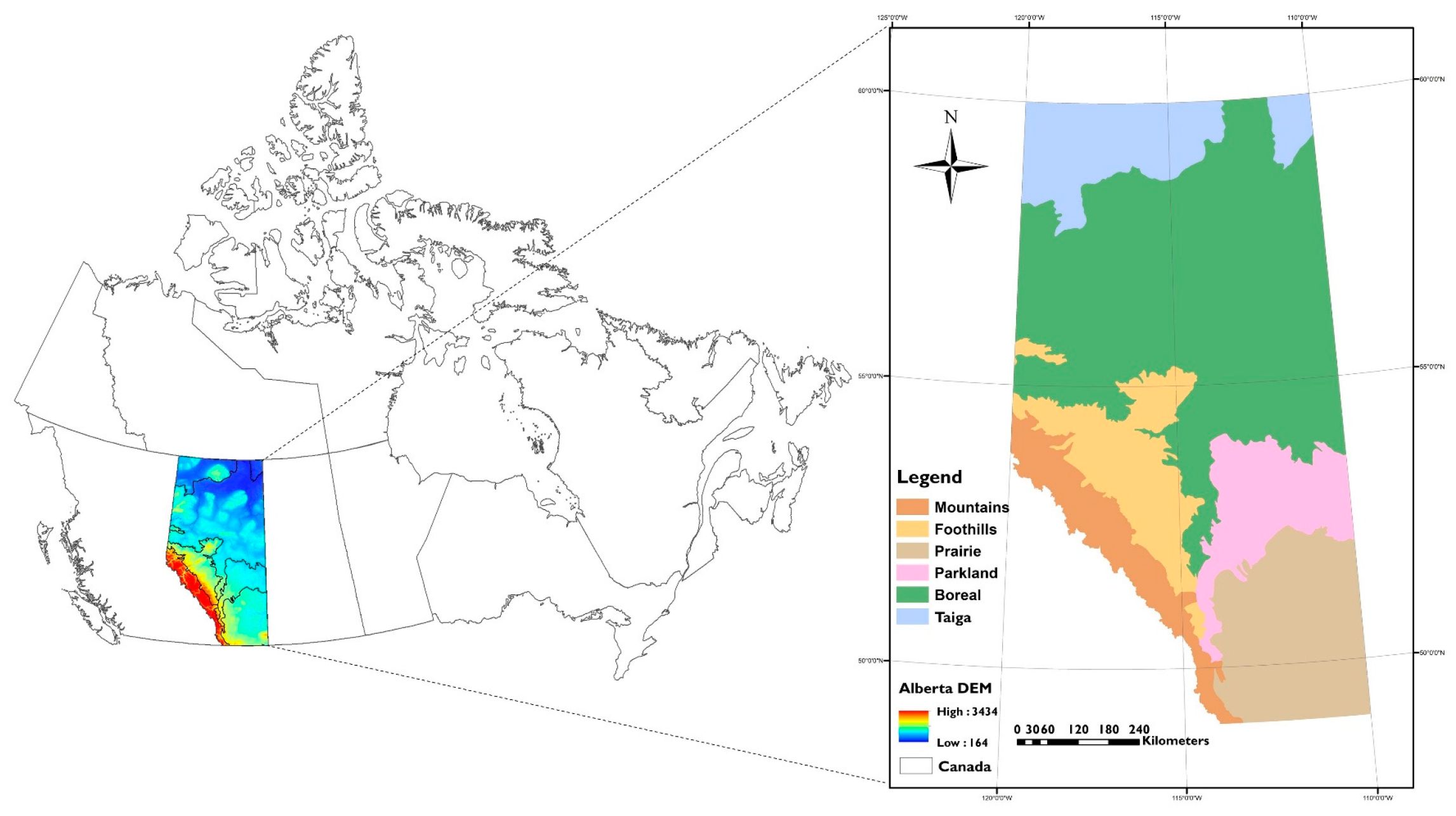

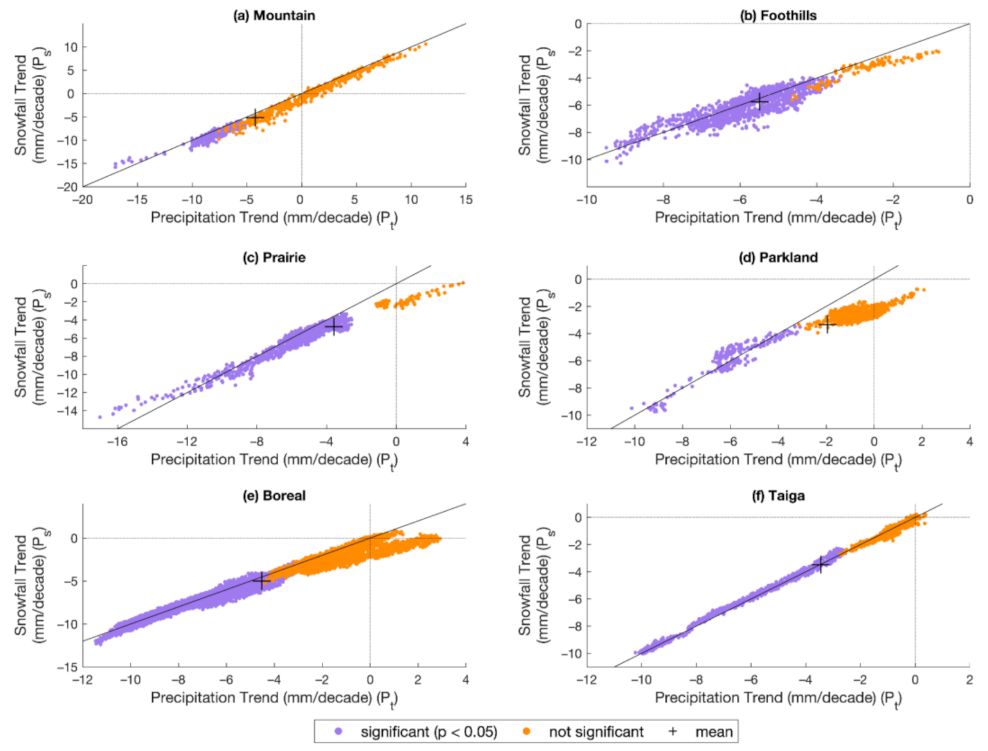
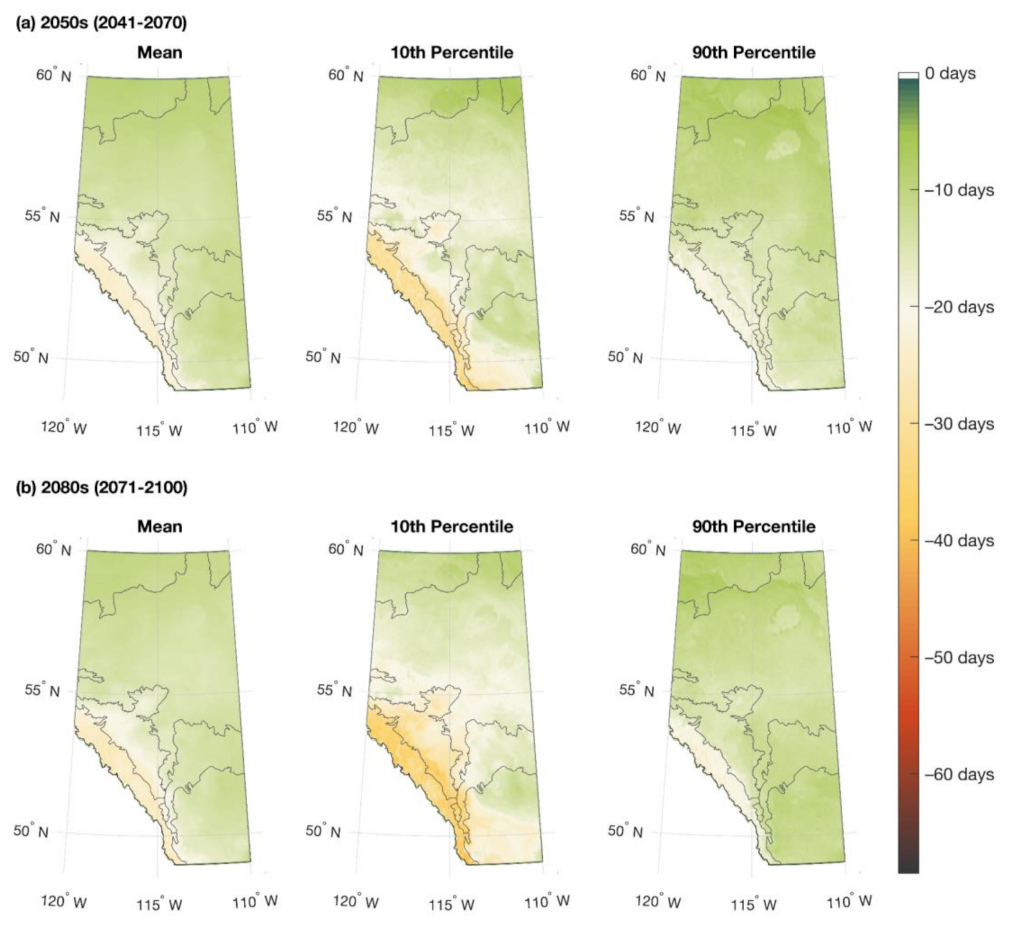
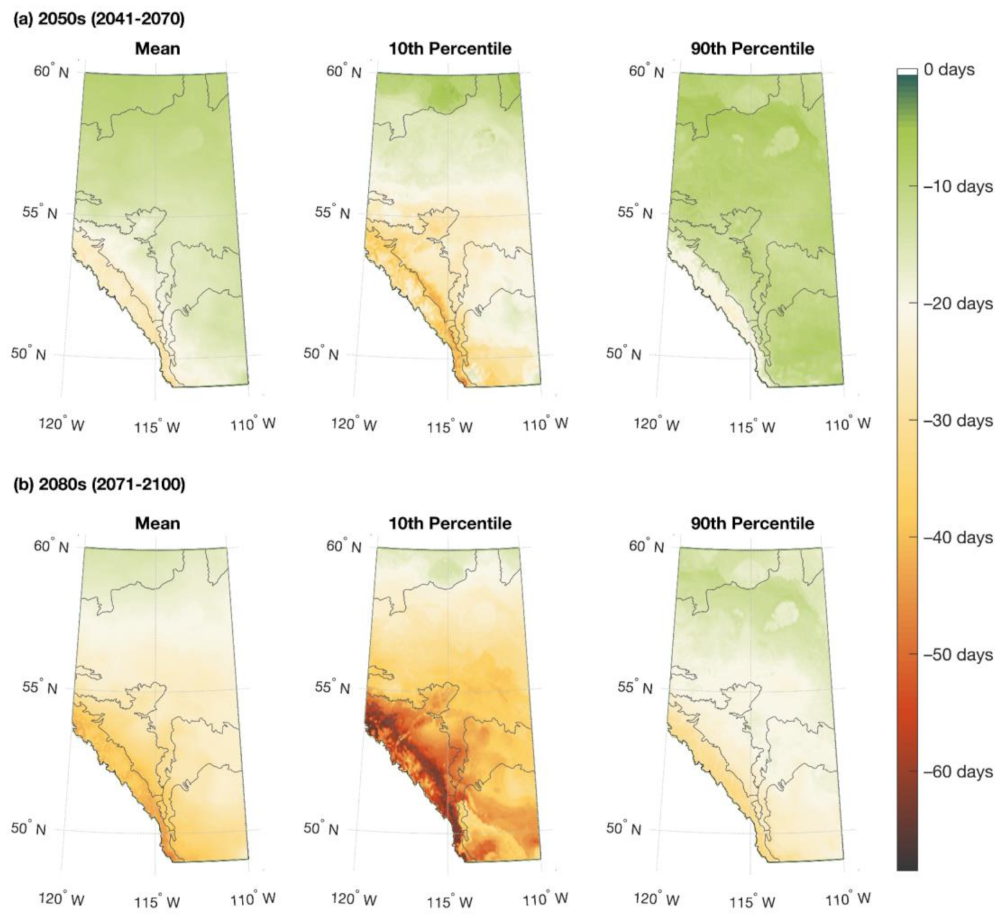
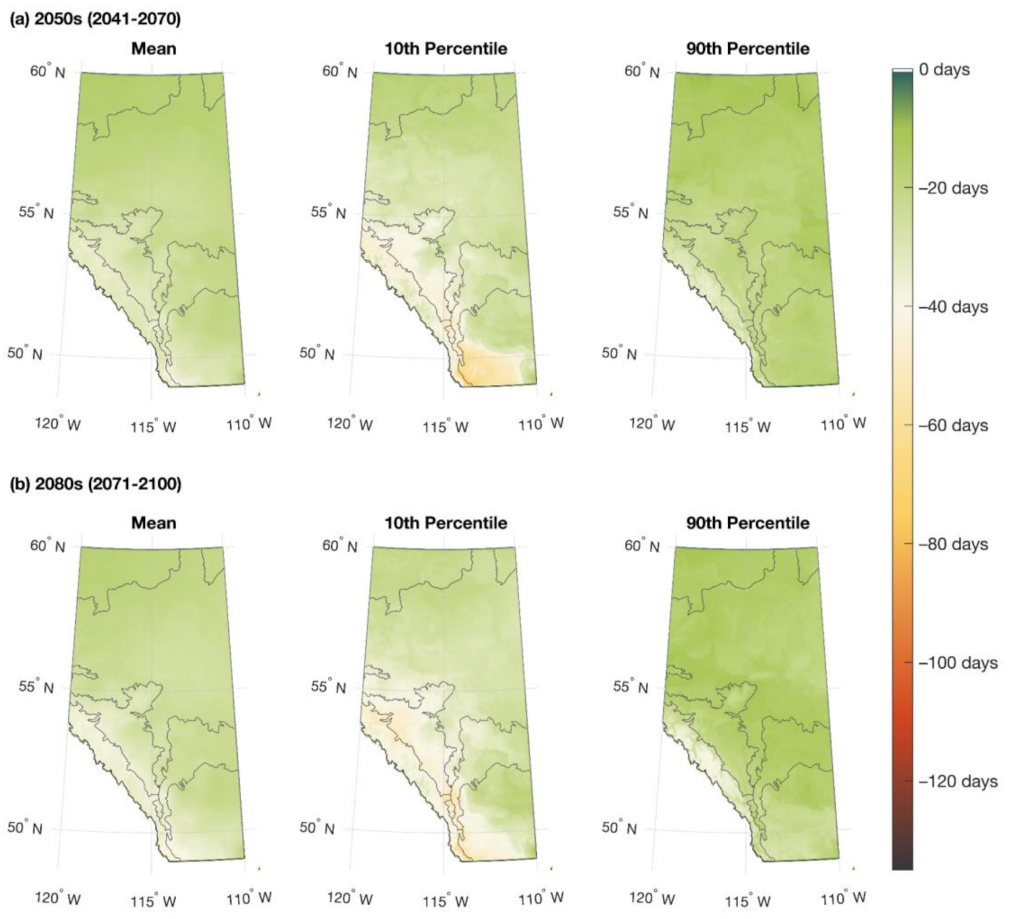
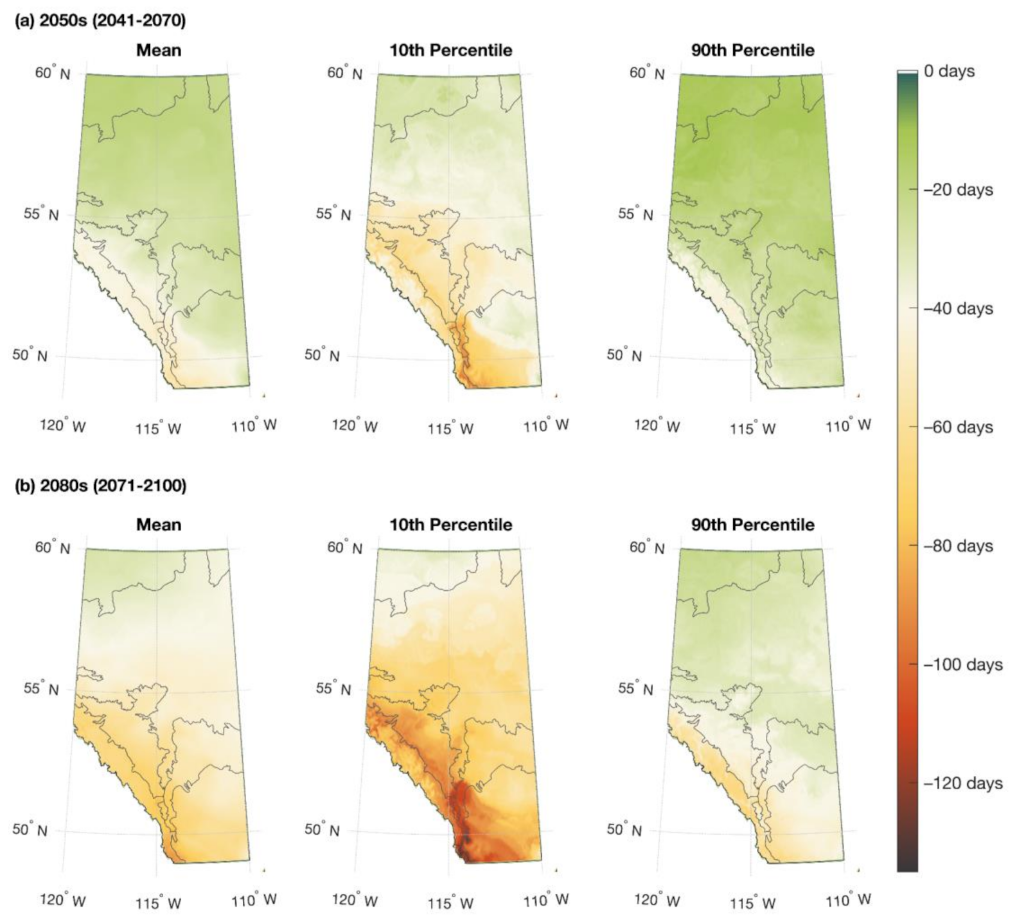
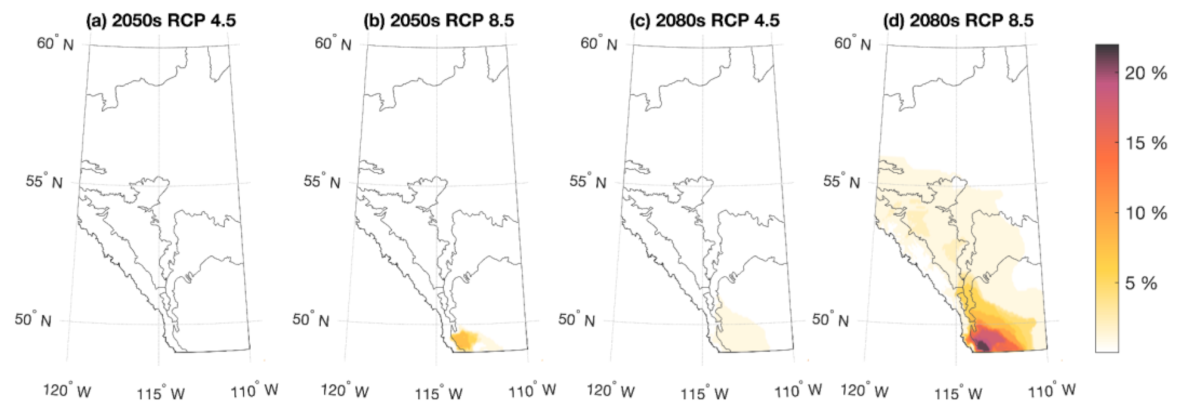
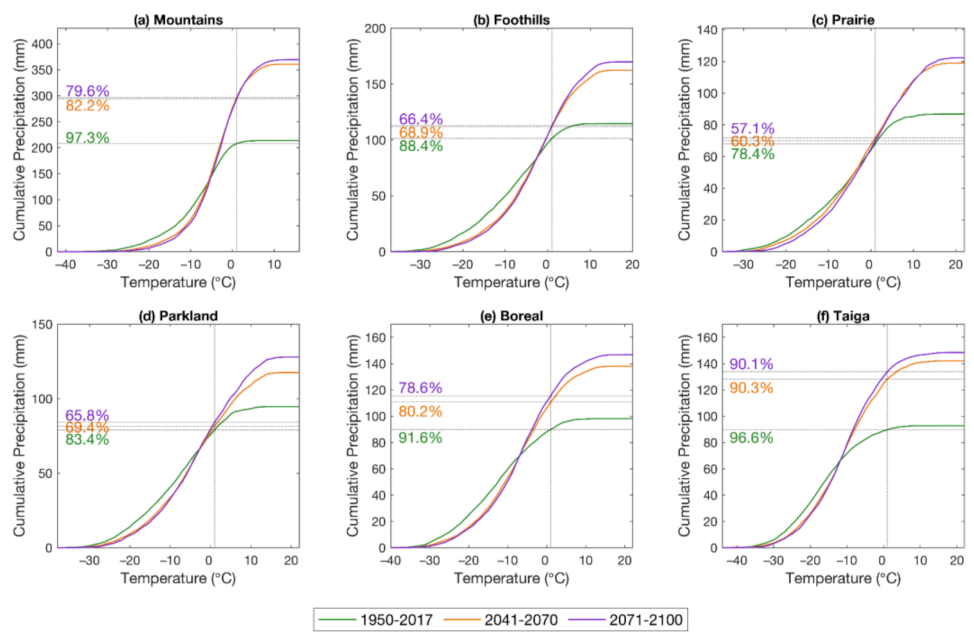
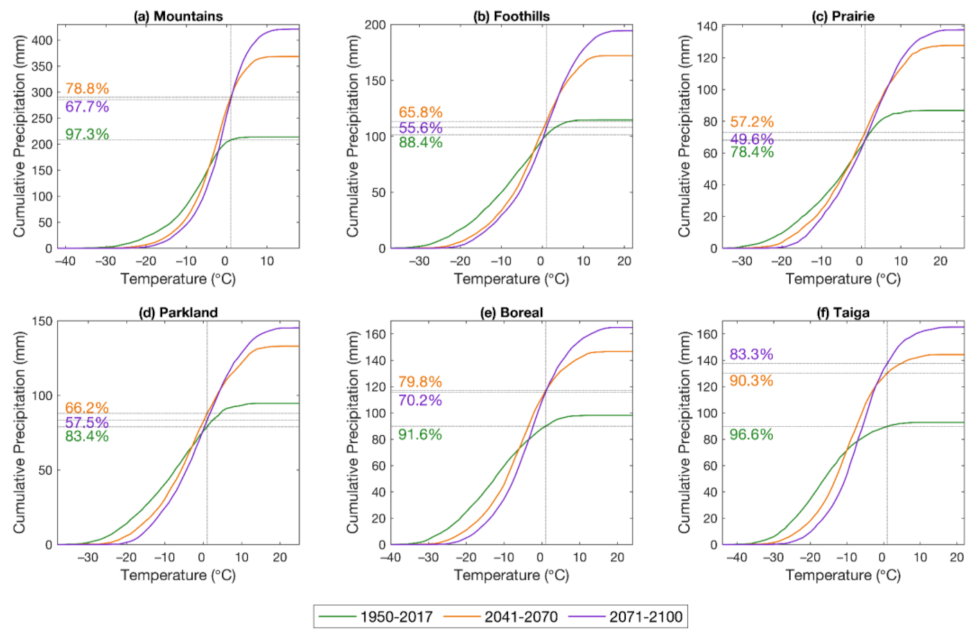
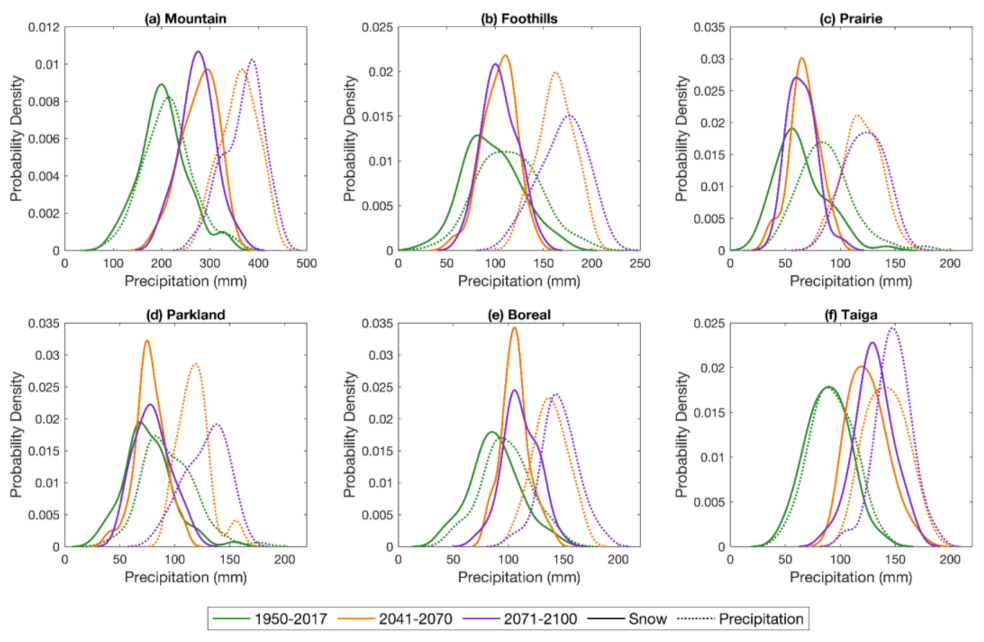
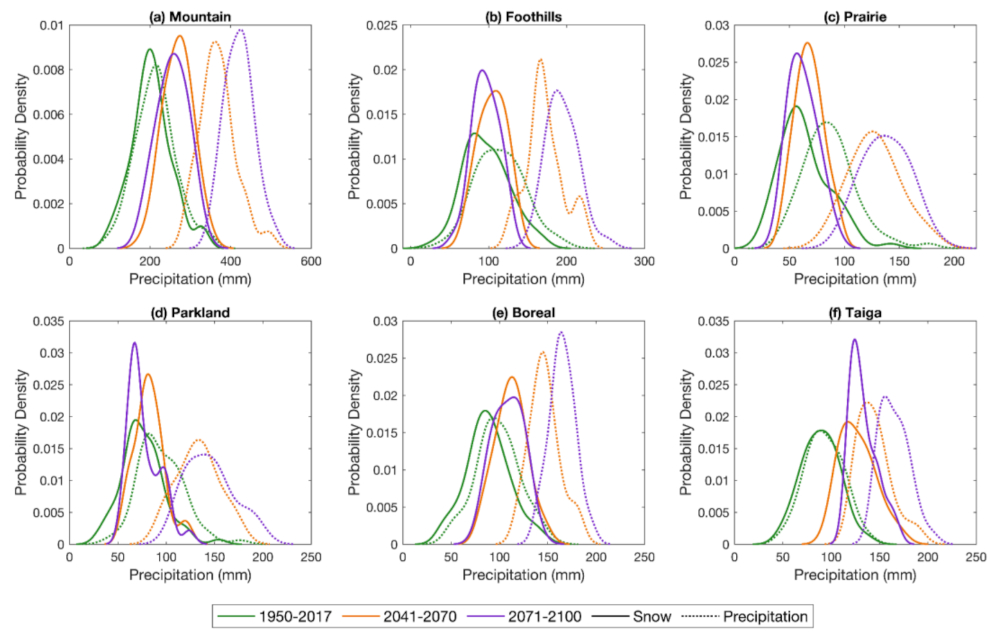
| Ecozone | Area (km2) | Elevation Range and Mean (m.a.s.l.) | Mean Cold Season Precipitation (mm) | Mean Cold Season Temperature (°C) |
|---|---|---|---|---|
| Mountain | 47,000 | 860–3630 (1890) | 214 | −0.5 |
| Foothills | 68,000 | 600–2450 (1060) | 115 | 1.8 |
| Prairie | 97,000 | 590–1710 (880) | 87 | 4.2 |
| Parkland | 59,000 | 510–2010 (770) | 95 | 2.6 |
| Boreal | 319,000 | 160–1230 (560) | 98 | 0.4 |
| Taiga | 72,000 | 190–1000 (480) | 93 | −2.2 |
| Model | Institution | Country of Origin |
|---|---|---|
| BCC-CSM1 | Beijing Climate Center, China Meteorological Administration | China |
| BNU-ESM | Beijing Normal University | China |
| CanESM2 | Canadian Centre for Climate Modelling and Analysis | Canada |
| ACCESS-1.0 | Australian Community Climate and Earth-System Simulator-Bureau’s Research and Development Branch | Australia |
| IPSL-CM5A-MR | Institut Pierre Simon Laplace | France |
| IPSL-CM5A-LR | Institut Pierre Simon Laplace | France |
| MIROC5 | Center for Climate System Research (University of Tokyo), National Institute for Environmental Studies, and Frontier Research Center for Global Change | Japan |
| MIROC-ESM | Center for Climate System Research (University of Tokyo), National Institute for Environmental Studies, and Frontier Research Center for Global Change | Japan |
| MIROC-CHEM | Center for Climate System Research (University of Tokyo), National Institute for Environmental Studies, and Frontier Research Center for Global Change | Japan |
| MPI-ESM-LR | Max Planck Institute for Meteorology | Germany |
| MPI-ESM-MR | Max Planck Institute for Meteorology | Germany |
| CCSM4 | National Center for Atmospheric Research | USA |
| HadGEM2-ES | Hadley Centre for Climate Prediction and Research | UK |
| HadGEM2-CC | Hadley Centre for Climate Prediction and Research | UK |
| CNRM-CM5 | Météo-France/Centre National de Recherches Météorologiques | France |
| CSIRO-Mk3-6-0 | Commonwealth Scientific and Industrial Research Organisation (CSIRO) Atmospheric Research | Australia |
| GFDL-CM3 | National Oceanic and Atmospheric Administration (NOAA)/Geophysical Fluid Dynamics Laboratory | USA |
| GFDL-ESM2G | National Oceanic and Atmospheric Administration (NOAA)/Geophysical Fluid Dynamics Laboratory | USA |
| GFDL- ESM2M | National Oceanic and Atmospheric Administration (NOAA)/Geophysical Fluid Dynamics Laboratory | USA |
| INMCM4 | Institute for Numerical Mathematics, Russia | Russia |
| MRI-CGCM3 | Meteorological Research Institute | Japan |
| CESM1-BGC | Community Earth System Model- National Science Foundation (NSF) and the U.S. Department of Energy (DOE) | USA |
| CMCC-CM | Euro-Mediterranean Center on Climate Change | Italy |
| FGOALS-g2 | National Key Laboratory of Numerical Modeling for Atmospheric Sciences and Geophysical Fluid Dynamics (LASG)/Institute of Atmospheric Physics | China |
| FGOALS-s2 | National Key Laboratory of Numerical Modeling for Atmospheric Sciences and Geophysical Fluid Dynamics (LASG)/Institute of Atmospheric Physics | China |
| NorESM1-M | Norwegian Climate Centre (NCC) | Norway |
| EC-EARTH | 22 academic institutions and meteorological services from 10 countries in Europe (http://ecearth.knmi.nl/, accessed on 1 April 2021) | Europe |
| GISS-E2-R | National Aeronautics and Space Administration (NASA)/Goddard Institute for Space Studies | USA |
| Mountain | Foothills | Prairie | Parkland | Boreal | Taiga | |||
|---|---|---|---|---|---|---|---|---|
| Mean | Historic (1950–2017) | 22-April | 03-April | 23-March | 31-March | 08-April | 18-April | |
| 2050s | RCP 4.5 | –3 | –18 | –14 | –14 | –13 | –10 | |
| RCP 8.5 | –26 | –19 | –17 | –16 | –13 | –10 | ||
| 2080s | RCP 4.5 | –25 | –19 | –15 | –14 | –14 | –11 | |
| RCP 8.5 | –39 | –31 | –30 | –27 | –22 | –16 | ||
| Standard Deviation | Historic (1950–2017) | 8.5 | 10.1 | 13.0 | 10.3 | 7.6 | 7.7 | |
| 2050s | RCP 4.5 | 7.3 | 7.4 | 8.6 | 6.8 | 5.4 | 5.0 | |
| RCP 8.5 | 7.3 | 8.1 | 7.9 | 7.1 | 5.6 | 5.3 | ||
| 2080s | RCP 4.5 | 7.9 | 9.1 | 9.4 | 8.2 | 6.3 | 5.3 | |
| RCP 8.5 | 10.3 | 10.3 | 8.9 | 8.8 | 7.8 | 6.7 | ||
| 10th percentile | Historic (1950–2017) | 10-April | 20-March | 05-March | 16-March | 28-March | 06-April | |
| 2050s | RCP 4.5 | –30 | –22 | –18 | –16 | –16 | –10 | |
| RCP 8.5 | –34 | –29 | –24 | –23 | –19 | –11 | ||
| 2080s | RCP 4.5 | –34 | –27 | –20 | –19 | –17 | –12 | |
| RCP 8.5 | –54 | –47 | –40 | –39 | –31 | –19 | ||
| 90th percentile | Historic (1950–2017) | 05-May | 17-April | 09-April | 14-April | 20-April | 29-April | |
| 2050s | RCP 4.5 | –19 | –16 | –14 | –14 | –11 | –9 | |
| RCP 8.5 | –19 | –12 | –10 | –12 | –10 | –10 | ||
| 2080s | RCP 4.5 | –20 | –15 | –11 | –12 | –12 | –9 | |
| RCP 8.5 | –30 | –23 | –23 | –21 | –17 | –14 | ||
| Mountain | Foothills | Prairie | Parkland | Boreal | Taiga | |||
|---|---|---|---|---|---|---|---|---|
| Mean | Historic (1950–2017) | 187 | 155 | 136 | 149 | 165 | 183 | |
| 2050s | RCP 4.5 | –33 | –29 | –26 | –24 | –21 | –17 | |
| RCP 8.5 | –44 | –35 | –37 | –31 | –24 | –20 | ||
| 2080s | RCP 4.5 | –36 | –31 | –28 | –25 | –24 | –19 | |
| RCP 8.5 | –69 | –59 | –60 | –52 | –42 | –32 | ||
| Standard Deviation | Historic (1950–2017) | 11.5 | 11.7 | 16.1 | 13.2 | 9.5 | 8.9 | |
| 2050s | RCP 4.5 | 9.3 | 9.7 | 12.2 | 8.7 | 6.8 | 5.8 | |
| RCP 8.5 | 11.6 | 13.1 | 12.8 | 11.6 | 10.2 | 8.0 | ||
| 2080s | RCP 4.5 | 7.5 | 10.7 | 11.2 | 9.8 | 7.4 | 5.0 | |
| RCP 8.5 | 14.6 | 16.4 | 15.6 | 14.8 | 12.8 | 10.3 | ||
| 10th percentile | Historic (1950–2017) | 168 | 140 | 112 | 132 | 151 | 171 | |
| 2050s | RCP 4.5 | –40 | –38 | –36 | –30 | –26 | –20 | |
| RCP 8.5 | –58 | –56 | –52 | –48 | –37 | –29 | ||
| 2080s | RCP 4.5 | –43 | –41 | –31 | –31 | –28 | –23 | |
| RCP 8.5 | –88 | –82 | –80 | –70 | –57 | –39 | ||
| 90th percentile | Historic (1950–2017) | 206 | 171 | 156 | 165 | 179 | 196 | |
| 2050s | RCP 4.5 | –29 | –22 | –18 | –18 | –17 | –13 | |
| RCP 8.5 | –36 | –24 | –28 | –24 | –17 | –14 | ||
| 2080s | RCP 4.5 | –31 | –18 | –21 | –15 | –16 | –14 | |
| RCP 8.5 | –58 | –40 | –45 | –37 | –32 | –26 | ||
Publisher’s Note: MDPI stays neutral with regard to jurisdictional claims in published maps and institutional affiliations. |
© 2021 by the authors. Licensee MDPI, Basel, Switzerland. This article is an open access article distributed under the terms and conditions of the Creative Commons Attribution (CC BY) license (https://creativecommons.org/licenses/by/4.0/).
Share and Cite
Newton, B.W.; Farjad, B.; Orwin, J.F. Spatial and Temporal Shifts in Historic and Future Temperature and Precipitation Patterns Related to Snow Accumulation and Melt Regimes in Alberta, Canada. Water 2021, 13, 1013. https://doi.org/10.3390/w13081013
Newton BW, Farjad B, Orwin JF. Spatial and Temporal Shifts in Historic and Future Temperature and Precipitation Patterns Related to Snow Accumulation and Melt Regimes in Alberta, Canada. Water. 2021; 13(8):1013. https://doi.org/10.3390/w13081013
Chicago/Turabian StyleNewton, Brandi W., Babak Farjad, and John F. Orwin. 2021. "Spatial and Temporal Shifts in Historic and Future Temperature and Precipitation Patterns Related to Snow Accumulation and Melt Regimes in Alberta, Canada" Water 13, no. 8: 1013. https://doi.org/10.3390/w13081013






